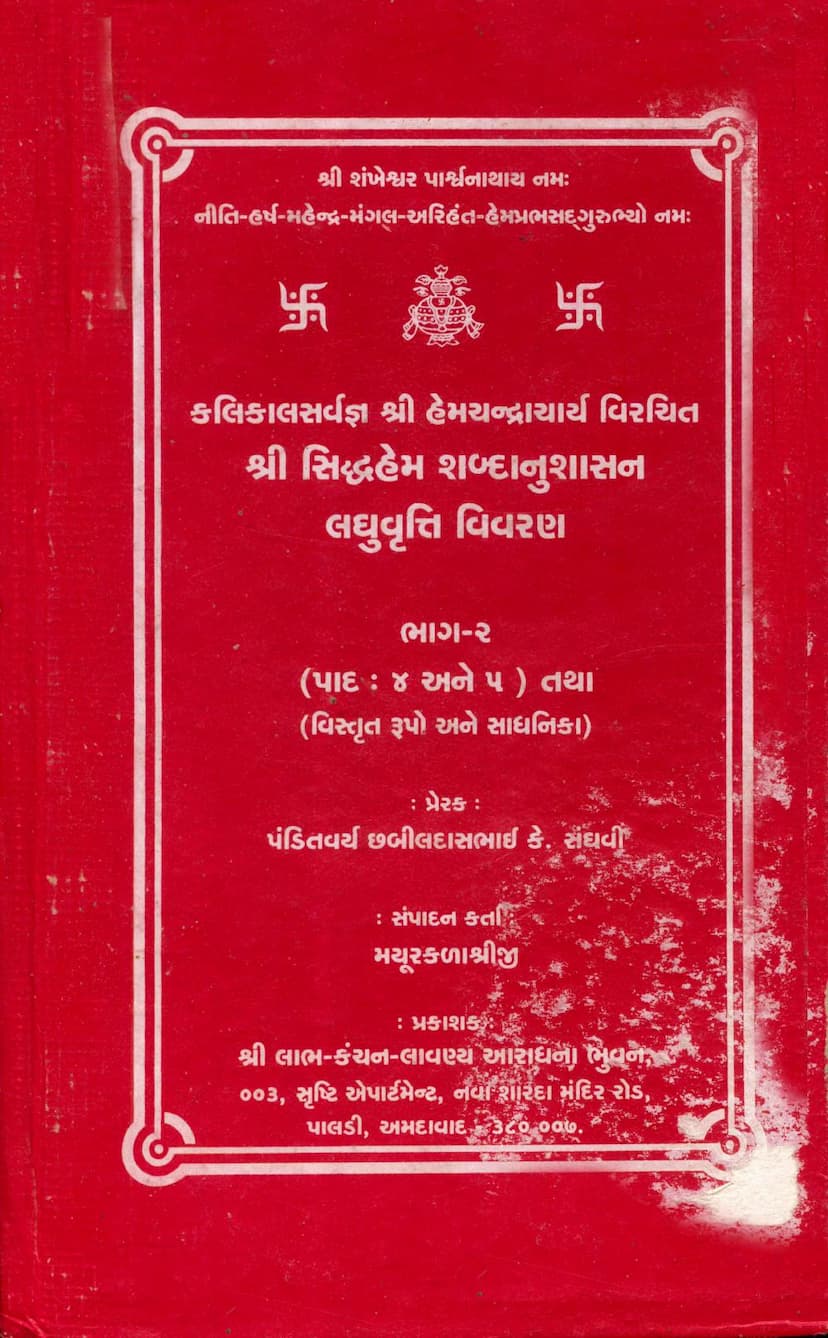Siddhhem Shabdanushasan Laghuvrutti Vivran Part 02
Added to library: September 2, 2025

Summary
Based on the provided Gujarati text, here's a comprehensive summary of the contents, focusing on the grammatical discussions and examples related to Hemachandra's Siddhhem Shabdanushasan:
Book Title: Siddhhem Shabdanushasan Laghuvrutti Vivran Part 02 Author(s): Mayurkalashreeji Publisher: Labh Kanchan Lavanya Aradhan Bhuvan
This volume, Part 2 of the "Laghuvrutti Vivran" on Hemachandra's Siddhhem Shabdanushasan, covers Chapters 4 and 5 of the fourth Pada (Chapter of Nouns/Inflection), along with detailed explanations of "extended forms" and "sadhikas" (grammatical analysis of word formation).
Key Themes and Content:
- Grammatical Analysis of Nouns (Fourth Pada): The text delves deeply into the inflection of nouns, covering a vast array of declensions and their specific rules. This volume meticulously explains the formation of various noun forms based on the sutras (rules) of Hemachandra's grammar.
- Detailed Examples and Sadhikas: Each grammatical rule (sutra) is illustrated with numerous examples, often complex and intricate, demonstrating their application. The "sadhikas" provide a step-by-step grammatical breakdown of these examples, explaining how the final form is derived from the root, prefixes, suffixes, and subsequent phonetic changes.
- Focus on Specific Sound Changes and Transformations: The text extensively discusses various phonetic changes (sandhi) and their impact on noun forms. This includes:
- Vowel and Consonant Changes: Detailed explanations of how vowels (like 'a', 'i', 'u', 'ṛ', 'e', 'o') and consonants transform based on the rules of elision (lopa), substitution (adesha), addition (agama), and vowel graduation (guna, vriddhi).
- Rules of Gender and Number: The text clarifies how noun forms change according to gender (masculine, feminine, neuter) and number (singular, dual, plural), often providing examples for each.
- Application of Pāṇini's Grammatical Principles (as interpreted by Hemachandra): The commentary likely references and explains the principles laid down by Pāṇini's Ashtadhyayi, as Hemachandra's work is a comprehensive system building upon and often refining Pāṇini's grammar. The text highlights specific nuances and exceptions in Hemachandra's approach.
- Explanation of Sutra Context and Purpose: The author, Mayurkalashreeji, and the "prerak" (inspirer) Pandit Chhabil Dasbhai K. Sanghvi, aim to make the study of Siddhhem Shabdanushasan accessible. The "vivran" (commentary) likely clarifies the intention behind each sutra, the context of its application, and resolves potential ambiguities or difficulties encountered by students.
- Index of Forms (Anukramanika): Page 8 and 9 provide an index of the forms discussed, listing a wide range of Sanskrit nouns and their corresponding page numbers, indicating the extensive coverage of the topic. This includes common nouns, pronouns, and words derived from verbs.
- Specific Grammatical Concepts Covered (as seen in the detailed sutra explanations):
- The text scrutinizes the meaning and application of terms like "svadi" (related to the 'sva' and 'adi' suffixes), "aluk" (non-elision), "lup" (elision), "pratyaya" (suffix), "adesha" (substitution), "gun" (vowel strengthening), "vriddhi" (vowel augmentation), "sandhi" (euphony), "nimit" (cause), "sthanivad" (treating an altered form as the original), "apavada" (exception), and "utsarga" (general rule).
- It addresses complex grammatical situations, such as the interaction of different rules, the application of principles in specific contexts (e.g., when a word is part of a compound), and the resolution of apparent contradictions.
- The commentary likely explains the rationale behind certain rules, such as why a specific suffix is used or why a particular sound change occurs.
Overall Purpose and Audience:
This book is a scholarly work intended for advanced students and scholars of Jain tradition and Sanskrit grammar. It serves as a detailed commentary to aid in the profound study of Hemachandra's seminal work on grammar, making the complex rules and their exceptions understandable through thorough analysis and illustrative examples. The preface indicates that this volume follows earlier parts and is part of a larger effort to make the entire Siddhhem Shabdanushasan accessible to a wider audience of sadhus, sadhvies, scholars, and spiritual seekers.
In essence, Volume 2 of this commentary provides an exhaustive grammatical exposition of a significant portion of Hemachandra's Siddhhem Shabdanushasan, focusing on the inflection of nouns with extensive examples and detailed analysis, crucial for mastering this foundational text of Jain tradition.